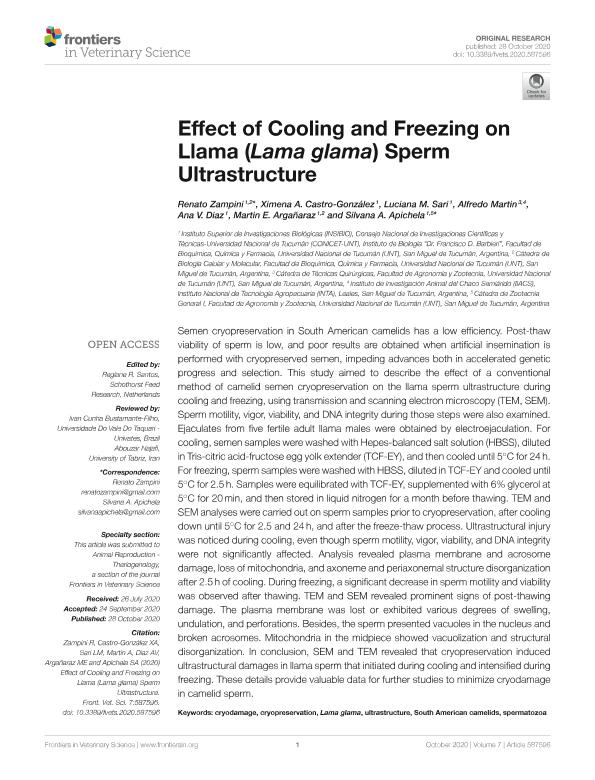Mostrar el registro sencillo del ítem
dc.contributor.author
Zampini, Renato

dc.contributor.author
Castro Gonzalez, Ximena Aixa

dc.contributor.author
Sari, Luciana María

dc.contributor.author
Martin, Alfredo
dc.contributor.author
Diaz, Ana Victoria

dc.contributor.author
Argañaraz, Martin Eduardo

dc.contributor.author
Apichela, Silvana Andrea

dc.date.available
2023-01-10T13:06:23Z
dc.date.issued
2020-10
dc.identifier.citation
Zampini, Renato; Castro Gonzalez, Ximena Aixa; Sari, Luciana María; Martin, Alfredo; Diaz, Ana Victoria; et al.; Effect of Cooling and Freezing on Llama (Lama glama) Sperm Ultrastructure; Frontiers Media; Frontiers in Veterinary Science; 7; 10-2020; 1-14
dc.identifier.issn
2297-1769
dc.identifier.uri
http://hdl.handle.net/11336/184114
dc.description.abstract
Semen cryopreservation in South American camelids has a low efficiency. Post-thaw viability of sperm is low, and poor results are obtained when artificial insemination is performed with cryopreserved semen, impeding advances both in accelerated genetic progress and selection. This study aimed to describe the effect of a conventional method of camelid semen cryopreservation on the llama sperm ultrastructure during cooling and freezing, using transmission and scanning electron microscopy (TEM, SEM). Sperm motility, vigor, viability, and DNA integrity during those steps were also examined. Ejaculates from five fertile adult llama males were obtained by electroejaculation. For cooling, semen samples were washed with Hepes-balanced salt solution (HBSS), diluted in Tris-citric acid-fructose egg yolk extender (TCF-EY), and then cooled until 5°C for 24 h. For freezing, sperm samples were washed with HBSS, diluted in TCF-EY and cooled until 5°C for 2.5 h. Samples were equilibrated with TCF-EY, supplemented with 6% glycerol at 5°C for 20 min, and then stored in liquid nitrogen for a month before thawing. TEM and SEM analyses were carried out on sperm samples prior to cryopreservation, after cooling down until 5°C for 2.5 and 24 h, and after the freeze-thaw process. Ultrastructural injury was noticed during cooling, even though sperm motility, vigor, viability, and DNA integrity were not significantly affected. Analysis revealed plasma membrane and acrosome damage, loss of mitochondria, and axoneme and periaxonemal structure disorganization after 2.5 h of cooling. During freezing, a significant decrease in sperm motility and viability was observed after thawing. TEM and SEM revealed prominent signs of post-thawing damage. The plasma membrane was lost or exhibited various degrees of swelling, undulation, and perforations. Besides, the sperm presented vacuoles in the nucleus and broken acrosomes. Mitochondria in the midpiece showed vacuolization and structural disorganization. In conclusion, SEM and TEM revealed that cryopreservation induced ultrastructural damages in llama sperm that initiated during cooling and intensified during freezing. These details provide valuable data for further studies to minimize cryodamage in camelid sperm.
dc.format
application/pdf
dc.language.iso
eng
dc.publisher
Frontiers Media

dc.rights
info:eu-repo/semantics/openAccess
dc.rights.uri
https://creativecommons.org/licenses/by-nc-sa/2.5/ar/
dc.subject
CRYODAMAGE
dc.subject
CRYOPRESERVATION
dc.subject
LAMA GLAMA
dc.subject
SOUTH AMERICAN CAMELIDS
dc.subject
SPERMATOZOA
dc.subject
ULTRASTRUCTURE
dc.subject.classification
Biología Reproductiva

dc.subject.classification
Ciencias Biológicas

dc.subject.classification
CIENCIAS NATURALES Y EXACTAS

dc.title
Effect of Cooling and Freezing on Llama (Lama glama) Sperm Ultrastructure
dc.type
info:eu-repo/semantics/article
dc.type
info:ar-repo/semantics/artículo
dc.type
info:eu-repo/semantics/publishedVersion
dc.date.updated
2021-04-28T21:05:41Z
dc.journal.volume
7
dc.journal.pagination
1-14
dc.journal.pais
Suiza

dc.journal.ciudad
Lausana
dc.description.fil
Fil: Zampini, Renato. Consejo Nacional de Investigaciones Científicas y Técnicas. Centro Científico Tecnológico Conicet - Tucumán. Instituto Superior de Investigaciones Biológicas. Universidad Nacional de Tucumán. Instituto Superior de Investigaciones Biológicas; Argentina
dc.description.fil
Fil: Castro Gonzalez, Ximena Aixa. Consejo Nacional de Investigaciones Científicas y Técnicas. Centro Científico Tecnológico Conicet - Tucumán. Instituto Superior de Investigaciones Biológicas. Universidad Nacional de Tucumán. Instituto Superior de Investigaciones Biológicas; Argentina
dc.description.fil
Fil: Sari, Luciana María. Consejo Nacional de Investigaciones Científicas y Técnicas. Centro Científico Tecnológico Conicet - Tucumán. Instituto Superior de Investigaciones Biológicas. Universidad Nacional de Tucumán. Instituto Superior de Investigaciones Biológicas; Argentina
dc.description.fil
Fil: Martin, Alfredo. Instituto Nacional de Tecnologia Agropecuaria. Centro de Investigaciones Agropecuarias. Unidad de Estudios Agropecuarios. Grupo Vinculado Instituto de Investigacion Animal del Chaco Semiarido A la Udea | Consejo Nacional de Investigaciones Cientificas y Tecnicas. Centro Cientifico Tecnologico Conicet - Cordoba. Unidad de Estudios Agropecuarios. Grupo Vinculado Instituto de Investigacion Animal del Chaco Semiarido A la Udea.; Argentina
dc.description.fil
Fil: Diaz, Ana Victoria. Consejo Nacional de Investigaciones Científicas y Técnicas. Centro Científico Tecnológico Conicet - Tucumán. Instituto Superior de Investigaciones Biológicas. Universidad Nacional de Tucumán. Instituto Superior de Investigaciones Biológicas; Argentina
dc.description.fil
Fil: Argañaraz, Martin Eduardo. Consejo Nacional de Investigaciones Científicas y Técnicas. Centro Científico Tecnológico Conicet - Tucumán. Instituto Superior de Investigaciones Biológicas. Universidad Nacional de Tucumán. Instituto Superior de Investigaciones Biológicas; Argentina
dc.description.fil
Fil: Apichela, Silvana Andrea. Consejo Nacional de Investigaciones Científicas y Técnicas. Centro Científico Tecnológico Conicet - Tucumán. Instituto Superior de Investigaciones Biológicas. Universidad Nacional de Tucumán. Instituto Superior de Investigaciones Biológicas; Argentina
dc.journal.title
Frontiers in Veterinary Science
dc.relation.alternativeid
info:eu-repo/semantics/altIdentifier/url/https://www.frontiersin.org/articles/10.3389/fvets.2020.587596/full
dc.relation.alternativeid
info:eu-repo/semantics/altIdentifier/doi/http://dx.doi.org/10.3389/fvets.2020.587596
Archivos asociados
